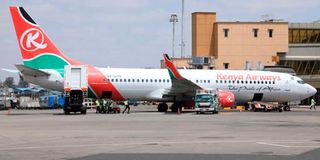How expensive fuel added Sh6 billion to Kenya Airways loss

A Kenya Airways plane at a parking bay at Jomo Kenyatta International Airport in this photo taken on July 27, 2022.
Expensive fuel propelled Kenya Airways’ losses in the first half of this year by nearly three times, exposing the risk side of the airline’s decision not to hedge jet fuel.
KQ said its pre-tax loss of Sh9.86 billion for the first half would have been a narrower Sh3.32 billion at last year’s fuel prices.
Stressing the fuel cost factor, Mr Allan Kilavuka, KQ’s managing director said, “our loss for the half year would have been Sh3.3 billion. That is comparable to probably our best year in 2018.”
In June alone, he added, KQ’s fuel prices had increased by 200 per cent compared to a similar month last year.
Fuel hedge positions
It is feared the trend will continue in the coming months.
Fuel constitutes 20 per cent of the airline’s costs and KQ said it has not had any fuel hedge positions this year.
The war in Ukraine, over the last six months, has caused a significant increase in fuel prices, having caught the carrier off-guard.
During this period, fuel costs for KQ were Sh11.1 billion, nearly 20 per cent of the Sh57 billion operating costs it reported.
The airline also said interest rates increased by 200 per cent, a factor that raised its finance costs, while local and global inflation affected travel.
“We know that we have significant risks ahead of us, particularly the financial risks relating to fuel, exchange rates, interest rates, and inflation”—factors the MD said “are outside our control”.
Kenya Airways said its pre-tax loss narrowed by 15 per cent in the first half of the year, helped by higher passenger and cargo revenue as borders reopened with the easing of Covid-19 restrictions. KQ reported a pre-tax loss of Sh9.86 billion, down from Sh11.542 billion a year earlier.
Revenue in the first half rose 76 per cent from a year earlier while operating costs increased 53 per cent.
The company’s chief finance officer Hellen Mwariri said the airline did not hedge on jet fuel in the first half but does sometimes and continues to review market developments.
“Our biggest issue is other foreign currencies that are fluctuating, mainly in Africa and you will not get any hedge positions for some of these African currencies because if you enter into such the costs will be higher than the benefits that you are looking for,” she said.
With the 2022 first half results, the airline continues with the loss-making trend it has been on for several years now but appears to be recovering from the deepest it sunk, in 2020, when it reported over Sh35 billion in losses.
While the carrier is banking on the completion of a restructuring programme with the government and the International Monetary Fund, which it expects will end by June 2023, to cut costs, it says it will be requiring significant financial support from the National Treasury.
Reduce staff costs
The airline said as part of cost-cutting, it’s in the process of returning two Embraer aircraft to their lessors after their lease terms ended, despite others being considered for return under the restructuring programme.
Mr Kilavuka also said the airline has frozen the hiring of new workers to keep its employee costs in check and to stay within the government’s directives that the airline rationalises its staff complement.
“We have significantly toned down on further recruitment. That has helped to reduce our staff costs,” the MD said.





